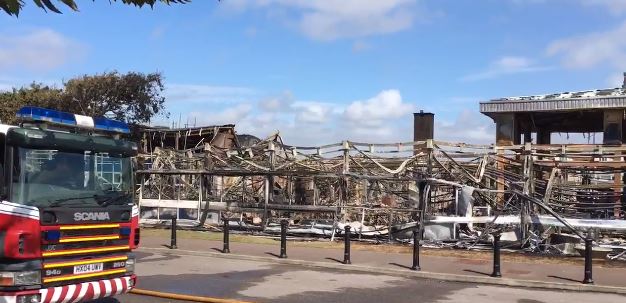The Fire Sector Federation (FSF) has urged the government to revisit fire-safety design guidance for schools in the wake of a fire that devastated a West Sussex school.
The Department for Education (DoE) recently proposed revisions to Building Bulletin (BB) 100: Design for fire safety in schools. However, FSF chairman Brian Robinson believes the revisions have “relegated the principles of property protection to an afterthought”.
Selsey Academy suffered extensive damage to its buildings and their contents during a blaze on 21 August. The start of term has been delayed until 12 September and the school’s 453 pupils will now be taught at four locations around the Selsey area.
At the scene of the Selsey Academy fire and it’s total devastation. Firefighters still extinguishing hotspots now pic.twitter.com/UIcjXDWvTm
— Steve Pickthall (@S_Pickers) August 22, 2016
The 2007 version of BB 100 recognises the societal impact of school fires and signposts users to a tool kit, developed by the Building Research Establishment (BRE), that takes a risk-based approach to determining an appropriate level of fire protection. The FSF has expressed concern that the government’s latest revisions have apparently overlooked these considerations.
Many of our members see no reason to change the current policy of a risk-based approach for the requirement to install sprinklers in schools and urge the Department to reconsider.” Fire Sector Federation Chairman Brian Robinson
“As we would expect the revised draft focuses quite correctly on the safety of occupants and their safe evacuation,” said Robinson.
“However, it appears to have relegated the principles of property protection to an afterthought and this fundamentally alters what the document seeks to achieve. Effective property protection can only be achieved through a blend of risk-appropriate active and passive measures and we believe that this principle is not fully emphasised in the new draft.
“We believe that guidance incorporating best practice for property protection is important because school buildings are funded by the taxpayer and in most cases some arm of government is the owner. BB100 should therefore give guidance on what is necessary to protect a public asset from fire.”
Sprinkler ommission
The Fire Sector Federation says that many of its members – which include bodies representing firefighters and the fire safety and construction industries – also expressed misgivings that the revised text neglected to advise that new school buildings should be fitted with a sprinkler system.
“Many of our members see no reason to change the current policy of a risk-based approach for the requirement to install sprinklers in schools and urge the department to reconsider,” said Robinson.
In July James Dalton, director of general insurance at the Association of British Insurers (ABI), called on the government to make sprinklers mandatory in care homes and schools.
The numbers of fires in educational establishments has fallen in recent years, a fact the DoE will feel vindicates its stance. However, the FSF has pointed out that the scale and cost of such fires is actually growing.
Research conducted by the Fire Protection Association (FPA) on behalf of UK insurers reveals 119 fires in schoold between 2009 and 2014 at a cost in excess of £150 million and £1.3 million per incident. The year on year average cost has soared from just £330,000 in 2009 to £2.8m in 2014.
Figures from the National Fire Sprinkler Network revealed that in at least 16 instances automatic fire sprinkler systems significantly reduced damage and disruption at school fires.
“There is little doubt that both active and passive fire protection and fire risk management is effective, so there would appear to be little logic in reducing requirements for any measures needed to maintain an appropriate level of property protection,” said Robinson.
2023 Fire Safety eBook – Grab your free copy!
Download the Fire Safety in 2023 eBook, keeping you up to date with the biggest news and prosecution stories from around the industry. Chapters include important updates such as the Fire Safety (England) Regulations 2022 and an overview of the new British Standard for the digital management of fire safety information.
Plus, we explore the growing risks of lithium-ion battery fires and hear from experts in disability evacuation and social housing.

